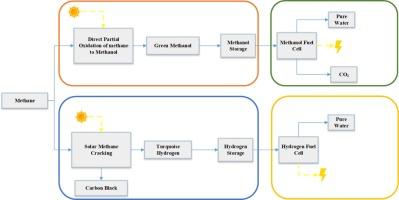Thermodynamic evaluation of solar energy-based methanol and hydrogen production and power generation pathways: A comparative study
IF 5.1
3区 工程技术
Q2 ENERGY & FUELS
引用次数: 0
Abstract
This work presents a comparative evaluation of two distinct fuels, methanol and hydrogen, production and power generation routes via fuel cells. The first route includes the methanol production from direct partial oxidation of methane to methanol using solar energy, where the methanol is condensed, stored, and sent to a direct methanol fuel cell. The second route is hydrogen production from solar methane cracking (named as turquoise hydrogen), where heat is supplied from concentrated solar power, and hydrogen is stored and directed to a hydrogen fuel cell. This study aims to provide insights into these fuels' production conditions, storage methods, energy, and exergy efficiencies. The proposed system is simulated using the Engineering Equation Solver software, and a thermodynamic analysis of the entire system, including all the equipment and process streams, is performed. The methanol and hydrogen route’s overall energy and exergy efficiencies are 39.75 %, 38.35 %, 34.21 %, and 33 %, respectively. The highest exergy destruction rate of 1605 kW is observed for the partial oxidation of methane to methanol. The methanol and hydrogen routes generate 32.087 MWh and 11.582 MWh of electricity for 16-hour of fuel cell operation for the same amount of methane feedstock, respectively. Sensitivity analysis has been performed to observe the effects of different parameters, such as operating temperature and mass flow rate of fuels, on the electricity production and energy efficiencies of the systems.

基于太阳能的甲醇和氢气生产及发电途径的热力学评估:比较研究
这项研究对甲醇和氢这两种不同燃料的生产和燃料电池发电路线进行了比较评估。第一条路线包括利用太阳能将甲烷直接部分氧化成甲醇,然后冷凝、储存甲醇,并将甲醇直接送入甲醇燃料电池。第二条路线是利用太阳能甲烷裂解制氢(被命名为绿松石氢),利用聚光太阳能提供热量,储存氢气并将其输送到氢燃料电池。本研究旨在深入探讨这些燃料的生产条件、储存方法、能量和放能效率。使用工程方程求解器软件对拟议系统进行了模拟,并对整个系统(包括所有设备和工艺流)进行了热力学分析。甲醇和氢气路线的总能效和放能效分别为 39.75 %、38.35 %、34.21 % 和 33 %。甲烷部分氧化成甲醇的放能破坏率最高,达到 1605 kW。在甲烷原料量相同的情况下,燃料电池运行 16 小时,甲醇和氢气路线分别产生 32.087 兆瓦时和 11.582 兆瓦时的电力。进行了敏感性分析,以观察不同参数(如工作温度和燃料的质量流量)对系统发电量和能源效率的影响。
本文章由计算机程序翻译,如有差异,请以英文原文为准。
求助全文
约1分钟内获得全文
求助全文
来源期刊

Thermal Science and Engineering Progress
Chemical Engineering-Fluid Flow and Transfer Processes
CiteScore
7.20
自引率
10.40%
发文量
327
审稿时长
41 days
期刊介绍:
Thermal Science and Engineering Progress (TSEP) publishes original, high-quality research articles that span activities ranging from fundamental scientific research and discussion of the more controversial thermodynamic theories, to developments in thermal engineering that are in many instances examples of the way scientists and engineers are addressing the challenges facing a growing population – smart cities and global warming – maximising thermodynamic efficiencies and minimising all heat losses. It is intended that these will be of current relevance and interest to industry, academia and other practitioners. It is evident that many specialised journals in thermal and, to some extent, in fluid disciplines tend to focus on topics that can be classified as fundamental in nature, or are ‘applied’ and near-market. Thermal Science and Engineering Progress will bridge the gap between these two areas, allowing authors to make an easy choice, should they or a journal editor feel that their papers are ‘out of scope’ when considering other journals. The range of topics covered by Thermal Science and Engineering Progress addresses the rapid rate of development being made in thermal transfer processes as they affect traditional fields, and important growth in the topical research areas of aerospace, thermal biological and medical systems, electronics and nano-technologies, renewable energy systems, food production (including agriculture), and the need to minimise man-made thermal impacts on climate change. Review articles on appropriate topics for TSEP are encouraged, although until TSEP is fully established, these will be limited in number. Before submitting such articles, please contact one of the Editors, or a member of the Editorial Advisory Board with an outline of your proposal and your expertise in the area of your review.
 求助内容:
求助内容: 应助结果提醒方式:
应助结果提醒方式:


